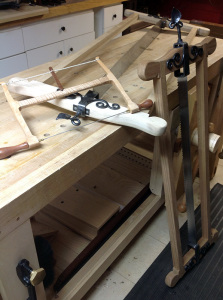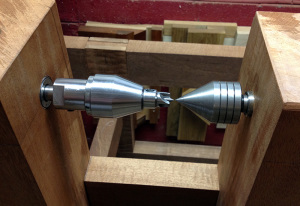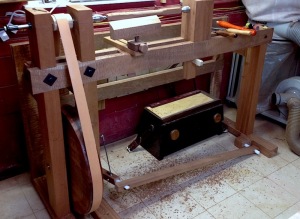Treadle Lathe Research and Development
 During WoodTalk the other night, Marc and I were talking about making your own tools. I confided that I would much rather build furniture than tools because with furniture you build it and then you are done. Yet in the last year I have built 4 lathes, 3 frame saws, a plane, and more miscellaneous shop appliances than I can count. I guess the real story is that tool making may not be my favorite thing but sometimes you just have to do what you have to do. I think the deeper issue is that today we are blessed with a lot of fine tools. The hand tool woodworker (or power tool user) has a lot of options to choose from in both new and vintage tools. Good tools work so well that they get forgotten about. A well tuned and balanced saw just works; you saw to the line and move on. The plane takes its shavings and you focus on the board and getting it flat not the plane.
During WoodTalk the other night, Marc and I were talking about making your own tools. I confided that I would much rather build furniture than tools because with furniture you build it and then you are done. Yet in the last year I have built 4 lathes, 3 frame saws, a plane, and more miscellaneous shop appliances than I can count. I guess the real story is that tool making may not be my favorite thing but sometimes you just have to do what you have to do. I think the deeper issue is that today we are blessed with a lot of fine tools. The hand tool woodworker (or power tool user) has a lot of options to choose from in both new and vintage tools. Good tools work so well that they get forgotten about. A well tuned and balanced saw just works; you saw to the line and move on. The plane takes its shavings and you focus on the board and getting it flat not the plane.
So when the tool doesn’t work your focus goes elsewhere. To the blister developing on your hand from an misshapen saw handle. To the loose lateral adjuster that wiggles and won’t hold your plane iron straight. Before you know if you are stopping work to fiddle with a tool that then leads to fiddling with something else until the end of your shop session arrives and you have made one saw cut and one pass over the board with the plane. It isn’t that good tools make your work better, it is that good tools allow you to focus only on your work. And that focus can’t but result in better quality projects.
This is all a long preamble to some frustration I have felt over my recent flywheel lathe build. There are many things I am thrilled with when it comes to this lathe but all it takes is one tiny thing to sour the entire experience.
Let’s look at the good:
- The construction is solid and heavy to dampen vibration throughout. The other day I unintentionally balanced a glass of water on the bed rails while I was turning further down the lathe. Nothing was spilled.
- The flywheel is massive and provides more than enough “power” while really while balanced. Plus the 1:12 gearing to the pulley means I can comfortably turn at 800-1000 rpms
- The modern headstock hardware is flexible and allows me to use the same chucks and accessories I use on my electric lathe. (including the Easy Chuck I’m reviewing, more on that soon)
- The height is custom to my own body so I am much more comfortable turning than I have ever been.
- The treadle is in exactly the right place so I can access it without even thinking about it making turning and moving your leg much easier than patting your head and rubbing your belly.
- Though I’m still developing this, the back rail for “onboard” storage of tools, chucks, and ancillary lathe stuff keeps me really organized with everything within arm’s reach.
So here is the bad which has been consuming all my time in the last month trying to fix:
- The spindle doesn’t run perfectly true. While it lines up with the tail stock, the headstock turns slightly out of round which makes for rough turning right by the drive spur.
- The belt slips a bit too easily on the pulley so at lower speeds I can stall the lathe with a medium cut
- My tool rest needs to be more stable as I get some flex at the extreme ends of the rest.
While this list is short, these shortcomings pack a punch and have continually frustrated me to the point where I have been turning almost 90% on my pole and bungee lathes because they work so much better. This is the perfect instance where the poorly functioning tool just gets in the way and you focus more on it than the project at hand. For every one step forward on my project, I take 7 steps back and to the side to address an issue with the tool. It is these interruptions that makes me say I don’t like making tools.
 So fast forward a few weeks and I have replaced the steel for the spindle which turned out to be slightly warped thus causing my wobble. I fiddled with the bearings for hours before I thought to check the spindle itself and fortunately that made for an easy fix.
So fast forward a few weeks and I have replaced the steel for the spindle which turned out to be slightly warped thus causing my wobble. I fiddled with the bearings for hours before I thought to check the spindle itself and fortunately that made for an easy fix.
I installed a new metal tool rest and changed the mounting on the banjo. My all wood solution before wasn’t precise enough to hold the post of my rest firmly so I extended the post and inlaid a steel pipe with an inner diameter to match the 1″ rest post. I then tapped a hole for an adjustment nut through the wood and steel banjo. Now the rest is rock solid even under a heavy roughing cut at the extreme ends of the 12″ rest. The rest is a bit short for longer spindles but I’ll design a longer rest with two posts in the future to address that.
The belt issue took a lot more fiddling. At first I roughed up the pulley so it would grip the belt more and used some violin rosin. This solved the problem temporarily but the belt quickly polished the pulley again and the slipping resumed. I installed no slip carpet tape knowing it would wear away quickly but wanted to see the effect of a sticky pulley. It worked like a charm but within 15 minutes of turning the tape had been pulverized and left a fine power all over my lathe. But my experiment proved fruitful. While the slipping mostly stopped it was still going on and it was this slippage that was abrading the pulley and polishing any grip away. I’m sure there is probably some kind of industrial strength abrasive that would hold up but now I was looking at an ongoing maintenance problem where the pulley would need to be refreshed from time to time.
So next installed an idler pulley on the back like most of the vintage lathes I have studied. The 12:1 gearing means that very little of the pulley was in contact with the belt so an idler would guide the belt around tighter arc and force more of the belt to contact the pulley. This stopped the slipping completely but added a lot more tension to the whole system and increased the effort required by me to maintain a high rpm. This was extremely discouraging because now I was huffing and puffing and sweating after just a few minutes of turning. It was then in one of those sit up in bed at 3 AM moments that it occurred to me that the idler’s job was not to make the belt tighter but to force more of the belt into contact with the pulley. So if I want to decrease tension yet force the belt through a longer path I would need a longer belt. Seems pretty obvious in hindsight but they don’t teach us this stuff in the College of Music. Fortunately the alligator lacing I used to join the belt makes it easy to join a new length of belt giving me the longer belt I needed. This lightened the tension substantially because now the belt wasn’t pressing against the idler but now just following the course. Moreover, with more touch points the belt wasn’t free to flap around and there was much less vibration in the entire transmission. I may further adjust the position of my idler in the future, but frankly I so happy to have the slippage issue resolved that I’ll let it rest for a bit while I put some miles on it.
With the major issues resolved I am back to turning efficiently and I am quite pleased with my treadle lathe…until last night…
While turning some Christmas gifts the lathe took a turn for the better (fooled you!) Over the course of a few hours turning the whole action smoothed out and the treadle seemed to respond with even less effort. I suddenly realized I was turning at a much higher speed than I was used and the pitch of the entire machine had changed into a healthy hum. What was a home built machine had suddenly become a smooth operating industrial wonder!
I now believe that ball bearings have a break in period. A period at which I have reached and I can now safely say that I would hold this lathe up against any modern lathe for spindle work. I’m still experimenting with faceplate work on it and haven’t yet tested the outboard turning capability. Any shortcomings I find there will most likely be due to my own lack of technique and not the lathe. I have often yearned for a vintage Barnes Treadle lathe like the one I use at the Steppingstone Museum, but now I’m not so sure. My lathe actually runs smoother now.
So in hindsight I discovered what it is about tool making I don’t like: the development process. The constant tweaking and testing of new ideas and failures that finally lead to a well honed machine that just disappears and lets you focus on the work. In my past tool builds I have been recreating time tested designs and standing on the shoulders of my forefathers. This lathe was different in that I studied many old designs but I added my own elements and synthesized about 40 different lathe designs. This was an untested design that obviously had some kinks to work out. Begrudgingly I worked through them and solved them. There may be more in the future as durability issues comes up but I think I may have finally gotten this design to the point where my imagination is realized. It was a frustrating process for me because I am just not wired that way, but now that the machine is tested I could not be prouder of my creation.
Major kudos to you tool makers out there whose research and development efforts go unseen and unrecognized. You make my woodworking so much better and allow me to build instead of tweaking tools.
(PS: those of you lucky Semester 5 members to The Hand Tool School will get a video update on these changes to the design once I finish filming the rest of the semester. Stay tuned.)



